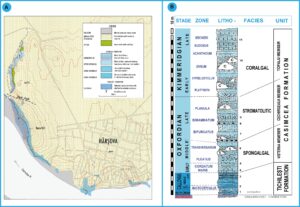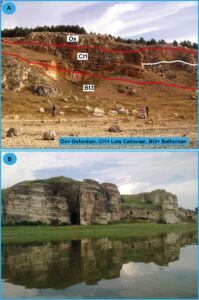To the Editors:
The GeoSite ‘Canaralele din Portul Hârșova’ (44°40’53.41” N, 27°57’4.41” E) is located in a hilly region on the right bank of the Danube River between Hârșova and Celea Mare Hill, integrated into the ‘Canaralele Dunării’ Natura 2000 site (ROSCI0022). This ‘canara’ landform comprises a dry and short valley with steep hillslopes developed in limestones formed through physical and chemical erosion (Posea 2006). The term ‘canara’ is a regionalism of Bulgarian origin used by locals for these valleys which means rock or cliff. North-to-south these are La Vii Hill, Baroi Hill (or Hârșova, see Fig. 1), Belciug Hill, the Cetate Hill (on which the Roman fortress of Carsium developed, see Fig. 1), Celea Mică, and Celea Mare Hills. The relief was modeled by limestone rock dissolution processes and of characteristic ravine and ruin type. Jurassic limestones outcrop in the Danube valley hillslope and generate cliffs of several tens of meters high. Important references dealing with research history, geological context, paleontological heritage, geotechnical features, and tourist potential data have been presented previously (e.g., Dragastan et al. 1998, Schweitzer et al. 2007, Leever et al. 2011, Seghedi 2012, Anițăi 2013, Andrei et al. 2013, Neagu et al. 2014, Schweitzer et al. 2017, and Dragomir & Dragomir 2017, Boote 2018).


Fig. 1. A, Băroi Hill - outcrop in the ancient Middle Jurassic and Lower Oxfordian pit. The man in these photographs is about 6 feet tall. B, Carsium Hill-Middle Oxfordian.
Geological strata in this region mainly involve sedimentary deposits, predominantly Jurassic fossiliferous limestones which overlie a Proterozoic basement (Green Shale Series). In the stratigraphic column, Cretaceous (Avram et al. 1996), Late Middle Miocene (Sarmațian), and Quaternary deposits are also present (e.g., Munteanu & Munteanu 1997, Steininger & Papp 1979, Venczel & Știucă 2008, Andreescu et al. 2013, Palcu et al. 2017, and Briceag et al. 2018). Jurassic deposits in this region comprise two lithostratigraphic units (e.g. Bărbulescu 1974), the Tichilești and Casimcea formations (Fig. 2).

Fig. 2. A, Geological map of the Hârșova area. B, Stratigraphic column of Tichilești and Casimcea formations (after Bărbulescu 1974, and Dragastan et al. 1998). Legend: 1, conglomerate and marls; 2, sparite limestones and sandstones; 3, cherts; 4, breccias; 5, limestones with cherts; 6, spongalgal biohermes; 7, biostromal; 8, stromatolitic limestone; 9, burrows; 10, coral biohermes and biostromes; 11, dolomite.
The Middle Jurassic Tichilești Formation (Late Bathonian - Early Callovian) is comprised of a number of lithologies including conglomerates, calcareous sandstones, biomicrite limestones, marlstones, calcarenites, and crinoidal sandy limestones. The fossil association is predominantly brachiopods [Septaliphoria steinbeisii (Quenstedt 1871), Terebratula maxillata (Sowerby 1825), Sphaeroidothyris sphaeroidalis (Sowerby 1825)], bivalves [Chlamis vagans (Sowerby 1826), Entolium demissus (Phillips 1835), Ctenostreom proboscideum (Sowerby 1820), Limatula gibbosa (Sowerby 1817), Homomya gibosa (Sowerby 1814), Placunopsis fibrosa (Laube 1867), Modiola gibbosus (Sowerby 1818), Pleuromya caudata (Terquem & Jourdy 1871), Goniomya sulcata (Agassiz 1845), Pholadomya angustata (Sowerby 1817),and Cercomya calloviensis (Kasansky 1909), as well as gastropods [Pseudomelania vittata (Phillips 1829)], corals [Porpites circularis (Alloiteau 1957)], echinoids [Collyrites ellipticus (Lamarck 1816), Collyrites analis (Agassiz 1835), Holectypus depressus (Leske 1778)], crinoids (Balanocrinus sp.), belemnites and ammonites [Macrocephalites macrocephalus (Schlotheim 1813), M. compressus (Quenstedt 1846), M. lamellosus (Sowerby 1840), Choffatia subbackeriae (d’Orbigny 1850)]. This Callovian fauna containing Macrocephalitidaes (Băroi Hill) is unique from Romania and is of biostratigraphic importance (Bărbulescu 1969).
The Late Jurassic Casimcea Formation (Oxfordian - Early Kimmeridgian) comprises cherty limestones, biostromal, biohermal, and micritic limestones, as well as dolomites. These deposits are thick and rich in fossils, including algae, sponges [Melonella radiata (Quenstedt 1858), Tremadictyon phylloideum (Antonescu 1927), Hyalotragos pezizoides (Goldfuss 1833),Cribrospongia reticulate (Goldfuss 1862), C. elegans (Schrammen 1937), Laocoetis parallela (Goldfuss 1826), Cylindrophyma milleporata (Goldfuss 1826)], corals [Stephanastraea jurassica (Roniewicz 1976)], mollusks [gastropods - Trochonatica Helvetica (Pictet & Campiche 1864), Harpagodes jaccardi (Pictet & Campiche 1864); bivalves - Isoarca explicata (Boehm 1881), Diceras speciosum (Münster 1839), Protocardia corallinum (Leymerie 1846), Meleagrinella echinata (Smith 1819)], cephalopods [Ochetoceras marantianum (d’Orbigny 1850), Lissoceratoides erato (d’Orbigny 1847), Taramelliceras costatum (Quenstedt 1849), Lithacoceras richei (de Riaz 1898), Sutneria galar (Oppel 1887), Euaspidoceras hypsellum (Oppel 1863), E. tietzei (Neumayr 1871), Physodoceras contemporaneum (Favre 1877),Epipeltoceras bimmamatum (Quensted 1858), Orthosphinctes tiziani (Oppel 1863), Perisphinctes (Arisphinctes) cotovui (Simionescu 1907), Neumannia sapunovi (Brochwicz-Lewinski & Rózak 1976), Orthosphinctes sp..], brachiopods [Lacunosella trilobataeformis (Wisniewska 1932), Torquirhynchia speciosa (Münster 1839), Juralina topalensis (Simionescu 1909), Zeillerina delemontana (Oppel 1858), Moeschia granulata (Boullier 1976), Dorsoplicathyris farcinata (Douville 1879)], echinoderms [Plegiocidaris coronata (Schlotheim 1820), Plegiocidaris cervicalis (Agassiz 1840)], foraminifera, and bryozoans. Coral and sponge reefs as well as stromatolitic bioherms are preserved in situ at Topalu, Visterna, and Hârșova.
Casimcea Formation outcrops are relevant because they expose:
- An entire fossil biome specific to a Late Jurassic carbonaceous platform (Oxfordian- Early Kimmeridgian), indicating shallow, oxygenated waters and a hot climate characterized by bioherms of sponges, stromatolites, and corals enriched with biostromal layers with marine invertebrate specimens from all groups;
- The unique shape of these spongalgal bioherms are similar to atolls known from across the entire European Jurassic sponge belt (Ungureanu & Barbu 2004);
- At least 30 Oxfordian species (i.e., ammonites, brachiopods, sponges, lamellibranchiates, and crabs) are found within this area (Hârșova -Topalu), a Type Locality. In terms of holotypes previously described Perisphinctes ponii (Simionescu 1907), P. multifidus (Simionescu 1907), Idoceras alternicostatus (Simionescu 1907), P. (Dichotomoceras) romanicus (Simionescu 1907), P. (Dichotomosphinctes) dobrogensis (Simionescu 1907), Decipia ernesti paucicostata (Simionescu 1907), Decipia pseudobreviceps (Simionescu 1907), Decipia topalensis (Simionescu 1907), P. (Arisphinctes) cotovui (Simionescu 1907), Pterocardium dobrogiacum (Simionescu 1910), Juralina schmidti (Simionescu 1910), J. topalensis (Simionescu 1910), Placothyris carsiensis (Simionescu 1910), Dorsoplicathyris petersi (Grădinaru & Bărbulescu 1994), Tremadiction phylloideum (Antonescu 1927), and Cycloprosopon dobrogea (Lazăr 2006), all of biostratigraphic importance;
- A unique assemblage of more than 30 species and brachiopod coquina are found in the Oxfordian-Early Kimmeridgian (especially in stromatolitic facies) (Grădinaru & Bărbulescu 1994);
- Ammonites, brachiopods, and sponges are represented by large specimens and by well-preserved examples.
Tichilești Formation outcrops are relevant because they expose:
- An Early Callovian Macrocephalitidaes (ammonites) fauna that is unique to Romania, and;
- One of the richest Romanian Middle Jurassic bivalve faunas.
Compliance with ethical standards
Authors’ contributions
All authors interpreted and discussed the results obtained and finalized the manuscript. All authors read and approved this final manuscript.
Availability of data and materials
All the data generated for this study are included in this published article.
Conflicts of interest
The authors declare that they have no competing interest. The view expressed in this short paper does not necessarily reflect those of their institutions.
Acknowledgments
This work was supported by ERCIP-European River Corridor Improvement Plans Project, funded through INTERREG IV C Program. The authors gratefully acknowledge the support from the Institute for Advanced Studies in Levant Culture and Civilization, Romania. We also acknowledge the effort of the Prof. Constantin Nicolae for his invaluable suggestions and kindness in critical reading of this manuscript. We also highlight the contribution of Prof. Victorița Nicolae who realized this new fossil collection was a great treasure of national heritage. Dr. Monica Macovei is also thankfully acknowledged for her help in improving the manuscript. Thanks to Dr. Albert Baltreș (Geological Institute of Romania) for preparation of figure 2. We are very grateful for the reviewers for their careful reading and constructive comments that improved the quality of the manuscript. Technical Editorial works by Mahshid Pezeshki are highly appreciated.
